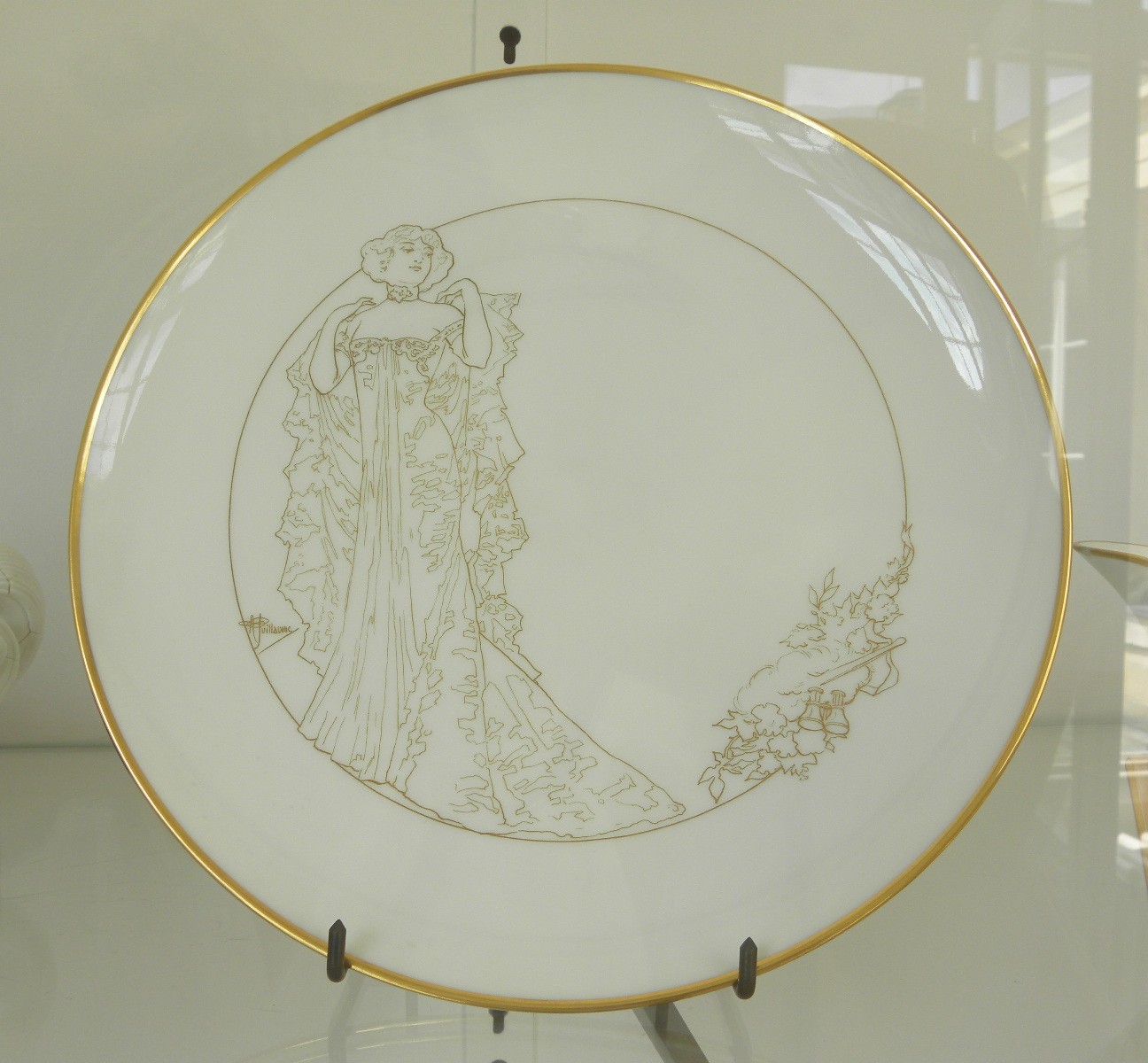 photos and post by Karen Samimi
photos and post by Karen Samimi
How is porcelain made, and what is it made of?
What’s the difference between porcelain and biscuit?
How hot does the hottest kiln get?
These are only some of the questions that will be answered during your visit to the National Manufacture of Sèvres that is part of the City of Ceramics.
The last time I visited the City of Ceramics in March, the porcelain Manufacture (Factory) was not open to the public. That’s not unusual: guided tours are only available by reservation for groups, on specific dates for individual visitors, or on annual Heritage Days in September. I was fortunate enough to have a reservation for one of the few guided tours for individuals in August.
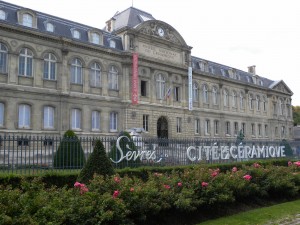 The Manufacture was founded in Vincennes in 1740 by a group of craftsmen and was moved to Sèvres in 1756 by King Louis XV and his mistress Madame de Pompadour. Because of their great interest in porcelain, they wanted Sèvres to create porcelain surpassing the established Saxony works of Meissen and Dresden. Sèvres is unique today in that the ancient crafts practiced there have been passed down from one generation to the next. Each object is produced manually from start to finish, with each craftsman marking their work. Each Sèvres craftsman completes a three-year training program to acquire a French state certification in ceramics and usually stays in a specific trade for most of his or her career. There are currently 120 artisans at the Manufacture working at 30 different ceramic trades.
The Manufacture was founded in Vincennes in 1740 by a group of craftsmen and was moved to Sèvres in 1756 by King Louis XV and his mistress Madame de Pompadour. Because of their great interest in porcelain, they wanted Sèvres to create porcelain surpassing the established Saxony works of Meissen and Dresden. Sèvres is unique today in that the ancient crafts practiced there have been passed down from one generation to the next. Each object is produced manually from start to finish, with each craftsman marking their work. Each Sèvres craftsman completes a three-year training program to acquire a French state certification in ceramics and usually stays in a specific trade for most of his or her career. There are currently 120 artisans at the Manufacture working at 30 different ceramic trades.
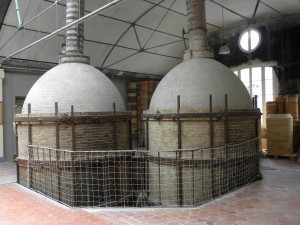 The tour began in the reception area of the National Ceramic Museum at the top of the staircase at the main entrance. The tour guide took us to the Manufacture building directly in back of the Museum, and we entered the “welcome room”. Here, our knowledgeable guide taught us about the history of the Manufacture and explained the porcelain-making process. Porcelain paste and plaster molds are used to make dishes, figurines, vases, and contemporary art, and examples of all of these were displayed. Proceeding into the adjoining room, we saw a porcelain bust of Louis XV made in 1760 and several other examples of objects made in Sèvres, as well as a wall map of the buildings on the site.
The tour began in the reception area of the National Ceramic Museum at the top of the staircase at the main entrance. The tour guide took us to the Manufacture building directly in back of the Museum, and we entered the “welcome room”. Here, our knowledgeable guide taught us about the history of the Manufacture and explained the porcelain-making process. Porcelain paste and plaster molds are used to make dishes, figurines, vases, and contemporary art, and examples of all of these were displayed. Proceeding into the adjoining room, we saw a porcelain bust of Louis XV made in 1760 and several other examples of objects made in Sèvres, as well as a wall map of the buildings on the site.
The tour proceeded to the workshops and storage and display areas on the lower and upper floors. The first thing I noticed was how large the Manufacture building is. Ambling through long corridors, our group passed by room after room of equipment, huge kilns, unfinished vases and plates, molds, and other production materials. We entered our first workshop which was for enamel glazing and were quickly welcomed by a young specialist who expertly explained her craft. She then gave us a demonstration by plunging her arm up to the elbow into a large bath to mix the enamel paste with water and then rapidly swooshing a plate through it with one hand. And, voilà! The plate was fully glazed and already practically dry, ready to go on to the next step in the long fabrication and decoration process. I really enjoyed this part of the tour.
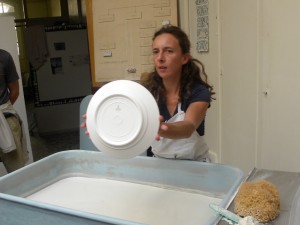 After making a short stop in front of several display cases showing the different phases of the porcelain painting process and a series of objects commissioned by different French institutions, we arrived at the gold decoration workshop. Here we were, in a large room that looked at first like an administrative office, but upon closer observation I realized that there were neither computers nor printers on the desks, and artisans’ fine tools had replaced pens and pencils. One man showed us how he transfers tiny engraved motifs from a gold-brushed metal slab to tracing paper using a special press, proud to share his unusual skills with our amazed group.
After making a short stop in front of several display cases showing the different phases of the porcelain painting process and a series of objects commissioned by different French institutions, we arrived at the gold decoration workshop. Here we were, in a large room that looked at first like an administrative office, but upon closer observation I realized that there were neither computers nor printers on the desks, and artisans’ fine tools had replaced pens and pencils. One man showed us how he transfers tiny engraved motifs from a gold-brushed metal slab to tracing paper using a special press, proud to share his unusual skills with our amazed group.
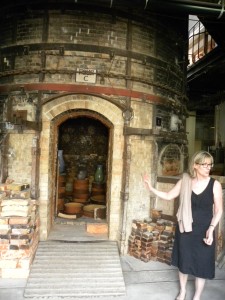 His colleague, a jovial woman about to retire after a career of 47 years there, demonstrated how she meticulously aligns and applies the gold tracing paper motifs to various porcelain objects, kind of like decals. It may take two or three days just to decorate a single teacup. On her desk and in a showcase nearby were examples of objects she had decorated. “Doesn’t this get a bit repetitive?” someone in the group asked. “The objects and motifs are always changing, so it stays interesting, and above all, we’re creating art”, she replied. I realized then that we were not just observing people working at their jobs. We were witnessing dedicated artists with a passion for using their unique “savoir-faire” to create lasting beauty for the world to admire.
His colleague, a jovial woman about to retire after a career of 47 years there, demonstrated how she meticulously aligns and applies the gold tracing paper motifs to various porcelain objects, kind of like decals. It may take two or three days just to decorate a single teacup. On her desk and in a showcase nearby were examples of objects she had decorated. “Doesn’t this get a bit repetitive?” someone in the group asked. “The objects and motifs are always changing, so it stays interesting, and above all, we’re creating art”, she replied. I realized then that we were not just observing people working at their jobs. We were witnessing dedicated artists with a passion for using their unique “savoir-faire” to create lasting beauty for the world to admire.
We concluded our tour in front of one of the oldest kilns in the Manufacture, a 19th century wood-burning kiln which is still fired up occasionally. It gets so hot that it takes weeks just to cool it off to remove the objects inside. It was fascinating to be able to walk inside this kiln and imagine how hot the factory gets when it’s used.
If you love artistry and handiwork of any kind, and especially if you love porcelain and would like to learn more about it, treat yourself to a memorable visit to the Manufacture of Sèvres.
PRACTICAL INFORMATION
2 Place de la Manufacture – 92310 Sèvres – +33(0)1 46 29 22 00
Manufacture and workshops:
Guided tours available with advance reservation for groups and individuals, from 1 ½ hours to 3 hours, including visits to 2 workshops.
Individual ticket prices between 12 and 14 euros, includes Museum’s permanent collections.
See website for specific visit dates and times.
For reservations and information call: +33(0)1 46 29 22 05
Free entry on annual Heritage Days in September.
National Ceramic Museum:
Open every day from 10 am to 5 pm except Tuesdays, January 1, May 1, and December 25.
Guided tours for groups and individuals available.
Theme tours available one Monday a month.
Free for visitors under age 18, ages 18-25 with European nationality, job seekers, handicapped, and on the first Sunday of every month.
Individual prices between 4.50 and 8 euros
Free entry on annual Heritage Days in September.
How to get there:
Metro line 9 : « Pont de Sèvres » stop (exit train at front, then use exit number 2), then walk over the bridge to the museum
Tramway T2 Val de Seine : « Musée de Sèvres » stop
Bus at Pont de Sèvres : 169, 179, 279, 171, 26 ( first stop after the bridge : « Musée de Sèvres »)
Paid parking available in front of the City, at the Tramway station and at the entrance to Parc de Saint-Cloud.

Now this is my kind of tour. I love ceramics and I love skilled artisans demonstrating their craft. And I love gold on porcelain. I’d be in heaven here.
I didn’t go with Karen, but I had a similar tour last Sept for the Journée des Patrimoines. It really is divine!
This was really fascinating. I have a French vintage shop so I see a lot of beautiful old ceramics and I’m always in awe of their craftsmanship and beauty. I really admire artists and artisans dedicated to their work and it makes me so happy to see that they’re still around and thriving. May they continue their labours of love for many, many years to come!
I look forward to checking out your vintage collection sometime soon!